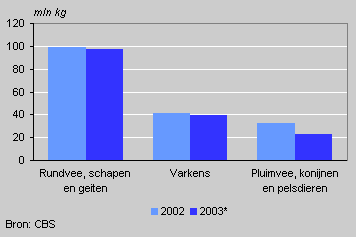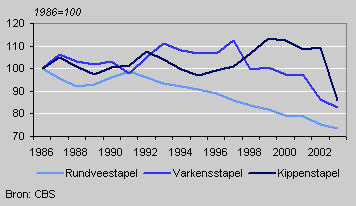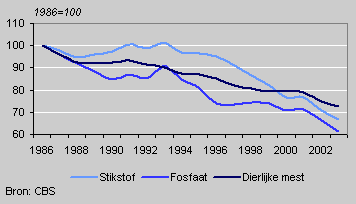Less nitrogen and phosphate in animal manure

The amount of phosphate in animal manure was 7 percent lower in 2003 than in the preceding year. The amount of nitrogen diminished by just over 5 percent. The decreases were caused by a reduction in livestock
Phosphate in animal manure

Fowl pest and diminishing livestock
About half the reduction in the amounts of nitrogen and phosphate was the consequence of the fowl pest outbreak in 2003. Nearly 30 million birds were destroyed between the beginning of March and the middle of May, about one third of the total number of poultry birds in the country.
Livestock, 1986=100

Overall a total 69 million tons of manure was produced in 2003. This is more than a quarter less than in the ‘top’ year 1986. In that year cattle still accounted for 85 percent of manure production. Because of the relatively strong decrease in cattle numbers, their share had dropped to 79 percent in 2003.
Strongest decrease in Brabant and Limburg
Because of the fowl pest, no figures are yet available on regional nitrogen and phosphate production in 2003. Figures for 2002 show that compared with 2001, the nitrogen and phosphate production dropped most sharply (by 10 percent) in North Brabant and Limburg, provinces with a lot of intensive livestock farming. North Brabant remained the province with the highest mineral production per hectare: 314 kg of nitrogen and 159 kg of phosphate. This is seven times the amount in Zeeland.
Nitrogen and phosphate in animal manure, 1986=100

Back to the level of the late sixties
Seen over a longer period (1986-2003), the total amount of nitrogen in animal manure has diminished by one third to 363 million kilograms. The amount of phosphate fell by nearly 40 percent in the same period, from 259 to 159 million kilograms.
This puts the phosphate production back at the level of the end of the sixties. Until 1997 the fall for phosphate was stronger than that for nitrogen. Since 1998, legislation and schemes to buy up livestock stimulated a further reduction of environmental pollution through animal manure.
Cor van Bruggen